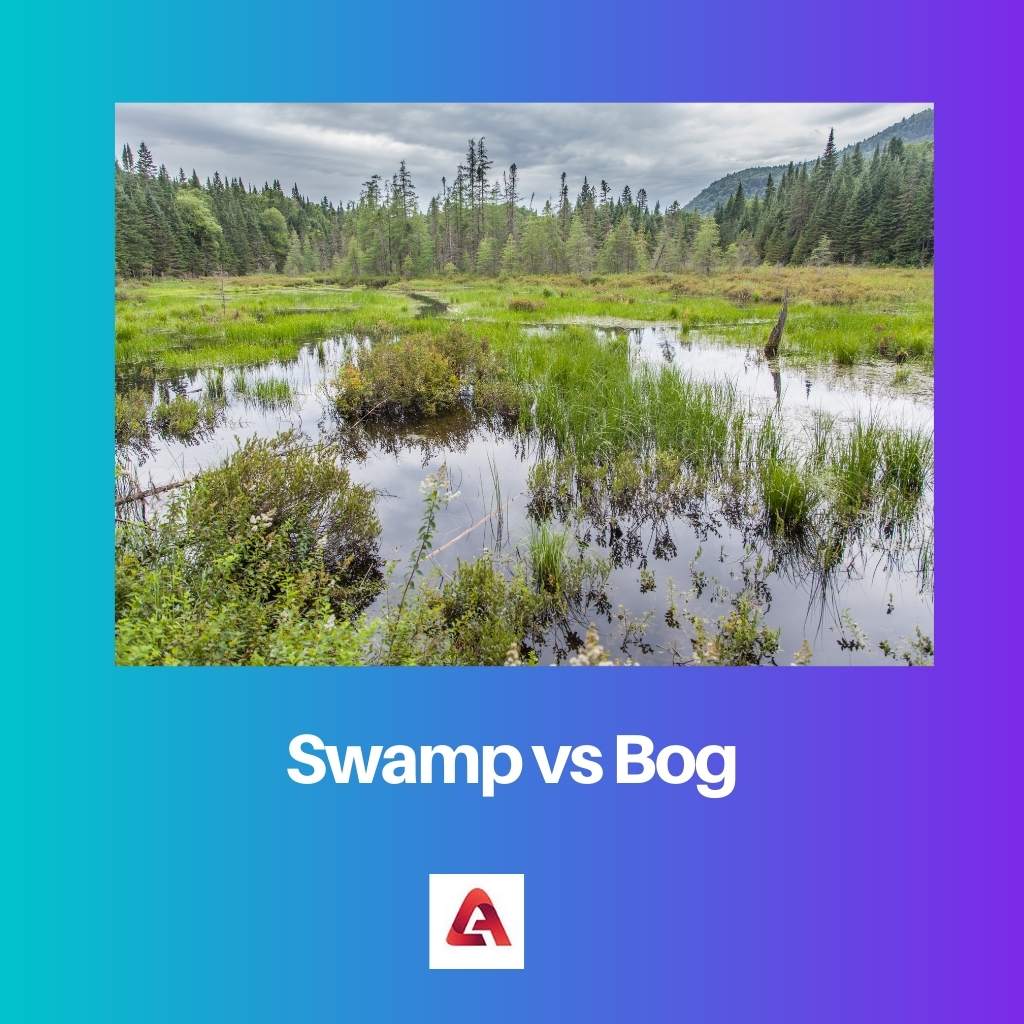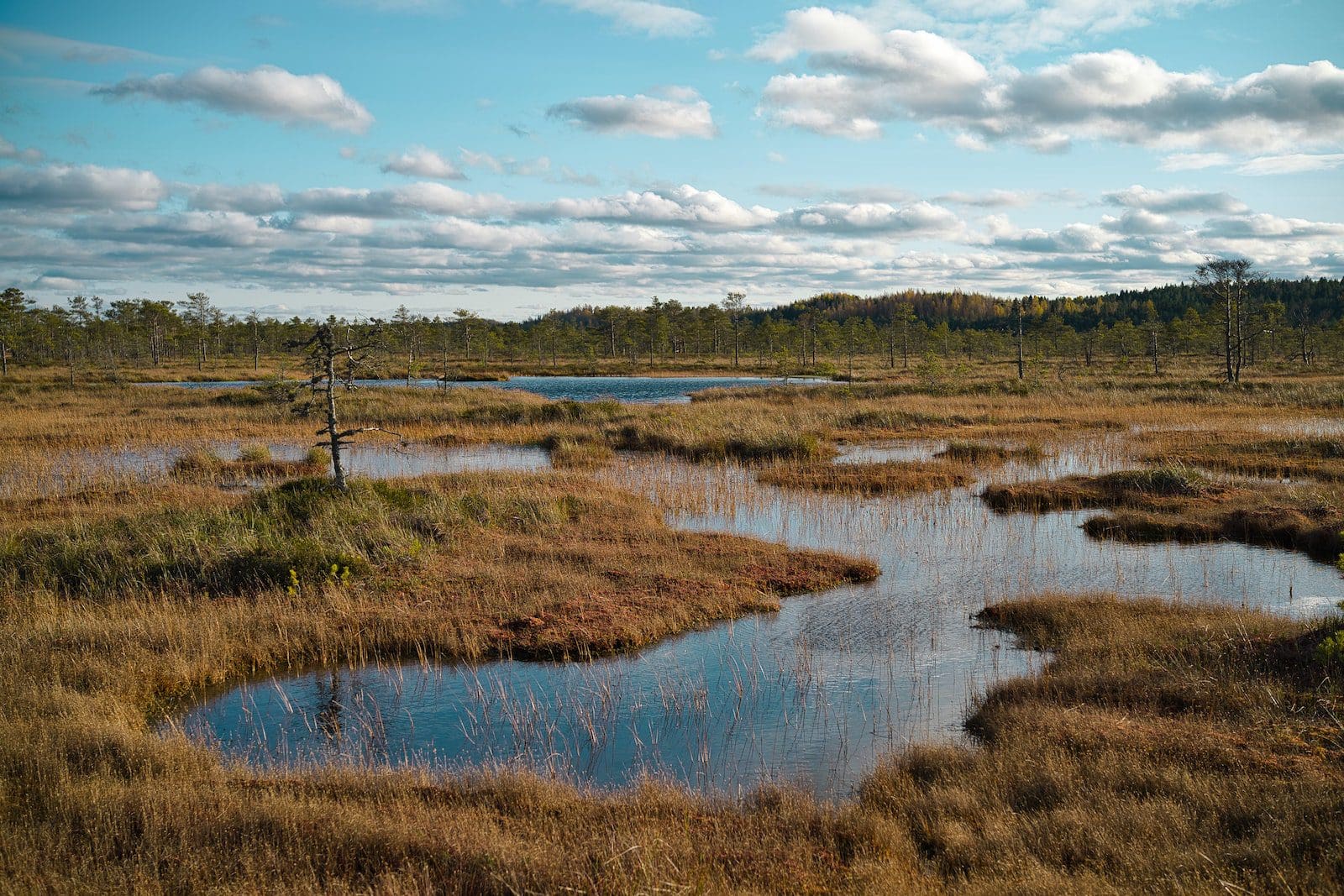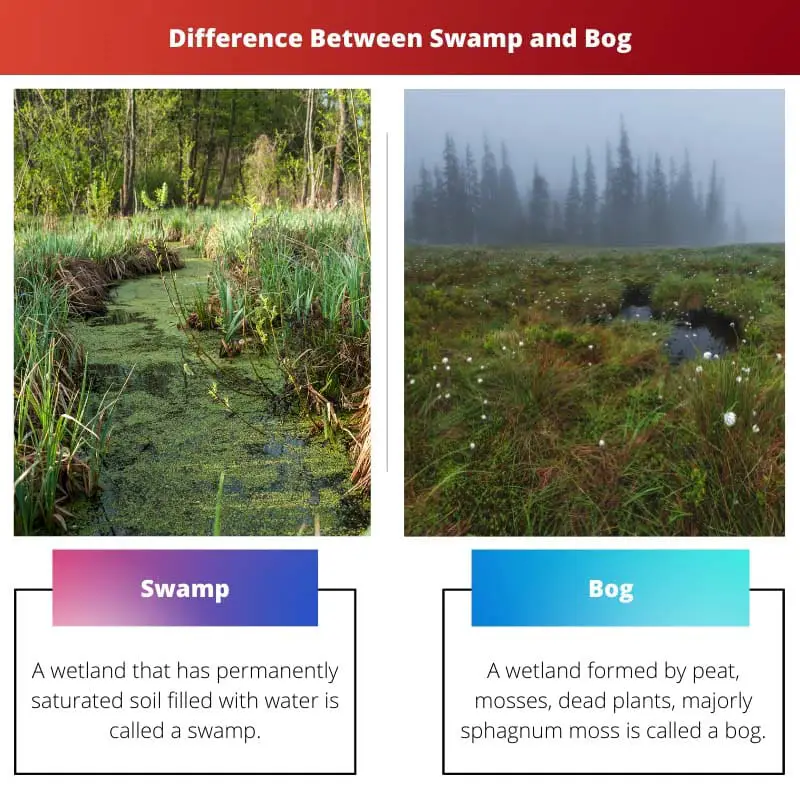A segment of the ecosystem flooded with water either seasonally or permanently with distinguishing features like vegetation of aquatic plants and adaptations of hydric soil is known as wetlands.
Key Takeaways
- A swamp is a wetland area characterized by standing water and covered by trees and other vegetation. At the same time, a bog is a wetland area characterized by stagnant water and dominated by peat moss.
- Swamps are found in areas with slow-moving or standing water, while bogs are found in areas with high rainfall or poor drainage.
- Swamps are more biodiverse and support a wider range of plant and animal life than bogs, which are nutrient-poor and support specialized plant species.
Swamp vs. Bog
The difference between swamp and bog is the soil in the respective wetlands. Swamps have muddy soil. On the contrary, bogs have peat soil. There are other differences between these two wetlands. The vegetation, animal life, and other parameters of these wetlands vary from each other as well.

A swamp is a wetland that has permanently wet and saturated soil. Swamps are the transition zones created by water and land. They vary in size, presence of water, presence of soil, etc., and are found in the entire world.
A wetland formed by peat, mosses, and dead plants, majorly sphagnum moss, is called a bog. A bog is also known as a mire, moss, quagmire, fens, Muskegon, etc.
Comparison Table
| Parameters of Comparison | Swamp | Bog |
|---|---|---|
| Definition | A wetland with permanently saturated soil filled with water is called a swamp. | A wetland formed by peat, mosses, and dead plants, majorly sphagnum moss, is called a bog. |
| Subtypes | Freshwater swamps, Saltwater swamps | Valley bogs, Raised bogs, Coastal bogs, Plateau bogs, Upland bogs, Kermi bogs, String bogs, Palsa bogs, Polygonal bogs, Blanket bogs, Quaking bogs, Contract bogs, Utrophic bogs, Mesotrophic bogs, Oligotophic bogs. |
| Uses | Purification of water, absorption of surplus water while floods, anchor soil, and sand near coastal areas. | Usage of sphagnum bogs for hunting and ecotourism, furniture manufacture by bog oak, harvesting of cranberries, blueberries, cloudberries, huckleberries, and lingonberries. |
| Also known as | No other word. | Mire, mosses, quagmire, fans. |
| Examples | Okefenokee swamp, Barley Barber swamp, Great Cypress swamp, Great Dismal Swamp, Atchafalaya basin, Vasyugan swamp, Bangweulu swamp, Okwango swamp, Asmat swamp, Candaba swamp, Mangrove swamp, Myristica swamp, Coomonderry swamp, Congaree swamp, Great Black swamp, Green swamp, Honey Island swamp, Louisiana swamplands. | Kakerdaja bog, Kuresoo bog, Niitvälja bog, Nigula bog, Ballynahone bog, Crymlyn bog, Matley bog, Max bog, Moseley bog, Yanal bog, Alfred bog, Burns bog, Glacier Park bog, McLean bogs, Minden bog, Pinhook bog, Rhine Center bog, Spruce Hole bog, Tannersville Cranberry bog, Strangmoor bog, Sifton bog, Volo bog, Zurich bog. |
What is Swamp?
A wetland with permanently saturated soil filled with water is called a swamp. Swamps play an essential role in biodiversity. They are such a segment of the ecosystem that has numerous uses.
Swamps are of two types, namely 1. Freshwater swamps, and 2. Saltwater swamps. The swamps that are created near rivers and lakes are called freshwater swamps.
Flowing water and saturated soil are the characteristic features of swamps. Sources responsible for water in wetlands include rivers, lakes or floods, etc. Swamps do water filtration in large quantities.
There are various swamps in different parts of the world. The Bangweulu Floodplains is considered the largest swamp in Africa.
Other significant examples of swamps include the Atchafalaya swamp, Okefenokee swamp, Barley Barber swamp, Asmat swamp, Myristica swamp, Congaree swamp, Great Black swamp, Great Cypress swamp, Great Dismal Swamp, Green swamp, Honey Island swamp, Vasyugan swamp, Mangrove swamp, etc.

What is Bog?
A wetland formed by peat, mosses, and dead plants, majorly sphagnum moss, is called a bog. Bogs play an essential role in the ecosystem. Bogs have several uses and properties.
The Occurrence of bogs is because of the presence of acidic and low-nutrient water at the ground surface. Several animals, fungal, and plant species reside in bogs. They are primarily found in cold and boreal ecosystems.
Several examples of bogs include Viru bog, Puhatu bog, Boora bog, Clara bog, Raheenmore bog, Cloncrow bog, Milltownpass bog, etc.
Varieties of bogs are Valley bogs, Raised bogs, Coastal bogs, Plateau bogs, Upland bogs, Kermi bogs, String bogs, Palsa bogs, Polygonal bogs, Blanket bogs, Quaking bogs, Utrophic bogs, Mesotrophic bogs, Oligotophic bogs.
The sans-oxygen environment where tannins are present in bogs is suitable for storing many organic compounds.

Main Differences Between Swamp and Bog
- The formation of swamps is because of water collected by rivers or lakes. On the other hand, either colonization of land by aquatic life or an increase in microbial activity is responsible for the formation of bogs.
- The uses and applications of swamps include the Purification of water, absorption of surplus water while floods, anchor soil, and sand near coastal areas. On the other hand, uses of bogs include manufacturing furniture with bog oak, carbon storage, mitigating climate changes, freshwater storage, etc.

While the article is informative and insightful, it might benefit from more visual aids such as images or diagrams to complement the detailed descriptions.
That’s a good point. Visual aids can enhance the understanding of the concepts presented in the article.
I agree. Some visual representations of swamps and bogs would make the article even more engaging.
The detailed comparison table is particularly useful in highlighting the distinctions between swamps and bogs. Great addition to the article!
The comparison table is indeed a standout feature. It serves as an excellent reference for understanding the unique characteristics of swamps and bogs.
This insightful article provides a comprehensive understanding of the characteristics and differences between swamps and bogs. Well done!
Absolutely agree. The article delves into the details of swamps and bogs, making it an enriching read.
The information provided in the article is detailed and thorough, offering valuable insights into swamps and bogs.
Absolutely. The article provides a rich understanding of the unique characteristics of swamps and bogs.
The detailed comparison presented in the article provides a comprehensive understanding of swamps and bogs. It’s a well-structured piece of informative content.
I concur. The article offers an in-depth exploration of the key differences between swamps and bogs.
Absolutely, the comparative analysis of swamps and bogs is very well-presented.
The information provided in this article is informative and educative. The comparison table made it easy to understand the key differences between swamps and bogs.
A very well-researched article. The description of the uses and characteristics of swamps and bogs is fascinating.
Absolutely, the clarity in differentiating between swamps and bogs is commendable. This article is a great source of knowledge on wetlands.
An excellent comparison between swamps and bogs. The information about the different types of wetlands is very detailed and easy to understand.
Right? I found the information provided in the article to be truly enlightening.
I agree, there’s so much to learn from this article. The detailed comparison of swamps and bogs is particularly interesting.
While the article is undoubtedly informative, it could benefit from a lighter tone to make the content more engaging for a wider audience.
That’s a valid point. Adding a touch of humor or wit could make the article more appealing to readers.
The high level of detail and the extensive comparison of swamps and bogs make this article a valuable resource for understanding wetlands.
Absolutely, the article offers a wealth of knowledge about swamps and bogs. A great read for those interested in ecosystems.
Agreed. The comprehensive information provided here is truly commendable.
The comparison table is a particularly helpful addition to the article, offering a clear overview of the distinctions between swamps and bogs.
Indeed, the tabular format enhances the clarity of differences between swamps and bogs. It’s an excellent reference point.